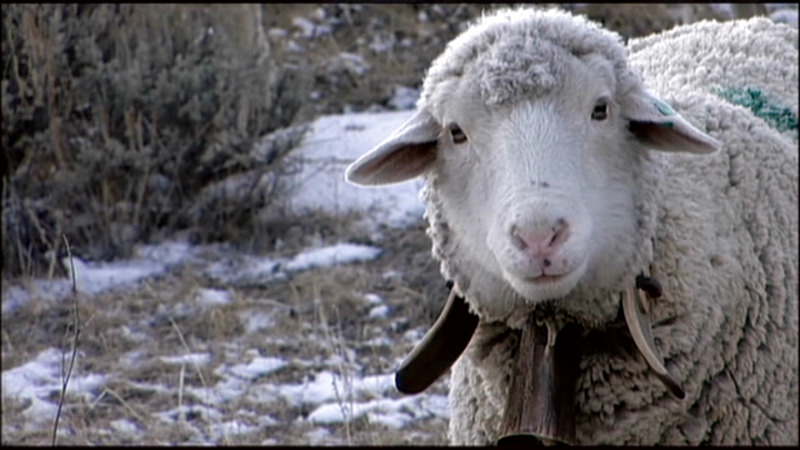Sweet Grass does concern itself with a ritual that is not only passing but is, apparently, done gone. Captions at the end of this lovely documentary tell us that sheep have been taken out to pasture on public lands, like the Absaroka-Beartooth mountains of Montana, where much of the action (or inaction) in Sweet Grass occurs, since the late 19th-century. But the drives filmed in 2001-2003 were the last, though we are not told why the practice ended.
A couple of additional statements about the context and history involved might have been useful. There is an acknowledgement to the Allested family and their ranch, but nothing to tell us that theirs is a Norwegian-American family who have been granted permits to graze their sheep on public lands for decades, or that it is they, their friends and Irish-American hired hands we see early on going about their work in late-winter. That said, one of the major strengths in this narration-free documentary is an avoidance of the big statement (that is left to the film's website and some reviewers of Sweet Grass). The expansive landscapes of Montana and the American West are a canvas on which people tend to paint in rather broad strokes. But filmmakers Ilisa Barbash and Lucien Castaing-Taylor let the land, the animals and their herders speak for themselves.
There's not much speaking to be heard early in Sweet Grass, the murmurs and whistles of the men and women of the ranch blending with the bleat and cry of sheep and the relatively newborn lambs. Some of the shots of the daily routines become nearly abstract, particularly a river of sheep being herded back into a barn, seemingly one big white blanket into which heads bob from below. In another sequence, we see sheep shorn of their wool coats (with what I couldn't help but think of as Flowbee-type devices). One newly shorn sheep walk unsteadily out, as if issued reluctantly from the womb. Lastly, a bunch of sheep standing out in the winter cold, looking rather chagrined at the whole process.
As the action turns to the summer drive of sheep through the mountains, the focus is as much on the landscape and herders as the herd itself. Increasingly, we're in the company of two men, John Ahern and Pat Connolly. The older Ahern seems cut more from the classic cowboy mold. He's certainly the more laconic and contented loner of the two. His weathered, squinting face is reminiscent at times of Warren Oates. At the end of one day's drive through the mountains, he murmurs in commiseration with his horse at the pleasure of getting away from all those sheep for the night. But then, as if to prove there are no hard feelings, he greets his charges at the new day with a series of "Good morning sheep...good morning sheep."
It's hard to say if Ahern, Connolly, or the others consider themselves cowboys. Another of the hands makes a joke about the dust-gathering nature of the cowboy brain much to the approval of his audience. Whether this is an indication of their insecurity at not being real cowboys, or an admirable penchant for self-effacing humor, is not entirely clear.
 |
| John Ahern |
 | |
| Pat Connelly |
During Connelly's hissy fit, the camera sweeps slowly and obliviously across some of the most beautiful country we have yet seen. It's hard to say if it's an ironic gesture on the part of the filmmakers, but it's certainly makes for striking counterpoint. Not that the landscape needs the comparison; it couldn't be much more majestic. The Montana summer sky itself is a thing of wonder, even on film. I sat and tried to think of names for shades of blue - azure, cerulean...anbody? - but what's the point, really? Beauty that profound and mercurial is hardly approached with words. It's like someone with an expressive countenance that is suffused and frequently, subtly altered from an inward play of intelligence and deep emotion. I'm reminded of Julianne Moore, beautiful in about two dozen ways in Louis Malle's Vanya on 42nd Street.
Once the sheep have been dropped off at drive's end, we see Ahern gathered in a friend's pickup and driven away. When asked what he plans to do next, Ahern, clutching a cigarette in between two dark, loose-skinned fingers, says he hasn't really thought about it that much. It's an indefinite ending, much as the practice of driving sheep over these lands seems to have run a definitive course. Sweet Grass is an imperfect but still valuable document of a kind relationship with land and animals that is increasingly a thing of the past in our country. At least the landscape persists for now.
db
**Jack Rebney is the one-time infomercial spokesperson made famous in the Found Footage Film Festival and later YouTube for his profane existential crises while trying to tout the virtues of Winnebago motor homes. Rebney's legend has grown to extent that he's the subject of a documentary, Winnebago Man.



Comments
Post a Comment